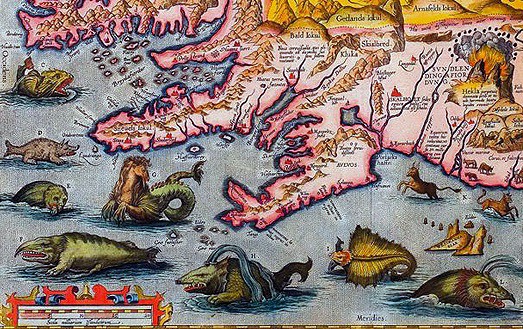How Did We Advertise Our Stupidity Before Social Media? I Can't Remember.
“A Subway worker who used a bread oven to dry her wet socks and gloves has become the centre of an internal investigation after she posted a picture of her carrying out the unhygienic act on her Instagram page.”
Your Conspiracy Theories Began 700 Years Ago Today
by Paul Fain

Jacques de Molay was burned at the stake 700 years ago this week. The unfinished cathedral of Notre-Dame de Paris — its towers completed just 65 years earlier — stood nearby as de Molay went up in flames. His death sparked conspiracy theories that have traveled through the centuries, across oceans and Ivy League campuses, and onto our flat-screen TVs.
As the last Grand Master of the Knights Templar, de Molay was considered a heretic by both the French Monarchy and the papacy. King Philip IV of France had him tortured and burned, slowly, on the Île de la Cité, the tiny Parisian Island in the Seine. It was March 18, 1314 — give or take a couple days.
Philip executed most of the other Templars, too. He used trumped-up charges to fuel public distrust about the shadowy group’s allegedly sacrilegious and homoerotic initiation rituals.
But as with Elvis’s death, Philip’s subjects didn’t buy that the Templars were really dead. (They also didn’t much like Philip expelling the Jews from France.) The order remains the Holy Grail of conspiracies, quite literally, as they are the supposed keepers of said grail. And their supposed power only seems to grow, helping to sell millions of copies of Dan Brown’s novels along the way.
If the descendants of the Templars have something planned for today, they aren’t talking. But some fans of the occult will take note of the anniversary.
Alas, they’re wrong to see any meaning in de Molay’s death. The truth behind the Templar’s extermination is neither glamorous nor mysterious. Despite our desperate desire to believe in secret societies, reality is as mundane as it is chaotic. If they still existed, the Templars could help it all make sense, by confirming our suspicions about the guys behind the guys, the ones who pull the strings.
The Templar’s diabolical connections are described in a whimsical tome by Christopher Hodapp and Alice Von Kannon called Conspiracy Theories & Secret Societies for Dummies (not to be confused with the Disney flick National Treasure).
The Catholic Church acknowledged the group in the early 12th century as a band of warrior monks, kinda like Thoros of Myr in “Game of Thrones.” It was just after the First Crusade, and the Templars’ self-appointed job was to protect pilgrims who had begun traveling to Jerusalem.
They set up shop in part of a royal palace on the Temple Mount, which supposedly stood above the ruins of the Temple of Solomon. Pledge week included vows of chastity, piety and poverty, sealed with an odd navel-kissing ceremony. Their uniform was a white smock with a red cross painted on it.
For the next two centuries, the Templars patrolled the Holy Land and Europe, fighting in several key battles. They morphed from something like Wells Fargo stagecoach guards into Halliburton. Like other orders before them, they had their eye on statehood, and so their end came quickly, in the seven years or so that climaxed with de Molay’s execution. By then the Templars had been excommunicated and thoroughly disbanded.
But that was just the beginning. The early Freemasons claimed ties to the Templars, despite a gap of a few hundred years between their creation and de Molay’s death. A dubious link to the old-school warriors apparently gave them some street cred.
As everyone — Wikipedia, Nick Cage, etc. — knows, most of the Founding Fathers were Freemasons. That means George Washington was basically a Templar. Yeah, he also grew hemp, man.
College fraternities arose from the Freemasons. Actual scholars say masons helped create several major fraternities. So frat dudes share a sinister connection to history’s baddest underlords. Similarly, fraternities continue to cause trouble with butt-chugging and other bacchanalian, hush-hush rituals.
The Templars also made an appearance in the news last week. Mexican police killed Nazario Moreno, the leader of a drug cartel that used the name Knights Templar. According to Time, Moreno’s followers wore white robes and kept statues of him wearing medieval armor. It’s unclear where he hid the Holy Grail.
In Foucault’s Pendulum, Italian philosopher Umberto Eco traces a bewildering constellation of secret brotherhoods. The novel’s plot revolves around a mysterious text its protagonist discovers. That document is the Templars’ secret plan to take over the world as payback for the execution of de Molay and his lieutenants.
Eco’s book is satirical. He’s riffing on the stickiness of tall tales about black helicopters and the Vatican’s bowels. The sacred versus the profane and whatnot. Foucault’s Pendulum is a meta antidote to The Da Vinci Code, which it predates, and the Templars’ fingerprints are all over both books, man. Eco writes:
The lunatic is all idée fixe, and whatever he comes across confirms his lunacy. You can tell him by the liberties he takes with common sense, by his flashes of inspiration, and by the fact that sooner or later he brings up the Templars.
The truth, however, is almost always boring. Ask any reporter who covers government. Bureaucratic ineptitude is a much safer bet than vast conspiracies.
In reality, the Templars were just early bankers. Cracking heads was a side gig, like aging Wall Street traders with a penchant for mud runs. And historians say the order’s prodigious wealth was their downfall. King Philip had them condemned to get that cash money. The Templars who survived the purge probably went back to being serfs somewhere.
https://giphy.com/gifs/uFOW5cbNaoTaU
But that story just doesn’t cut it to a world obsessed with the roots of the Illuminati, which, according to the Internet, is a dominant secret society run by Beyoncé, George Soros and the Bilderberg group. Life is dull place if everything can be explained by garden variety corruption.
Fiction can help. Take HBO’s “True Detective.” Fans of the show spent weeks going down a rabbit hole of Templar-esque theories about the Yellow King, Carcosa and a cover-up led by an evangelical U.S. Senator. But in the end, there was nothing there but a bad guy. Viewers were left disappointed that the big conspiracy was never unraveled in a finale that was more Lethal Weapon than Ambrose Bierce.
But they’re wrong. A worthy tale about dark secrets has to leave questions hanging. Long live the Yellow King.
A small stone marks the spot at the foot of the stairs to the Pont-Neuf bridge where de Molay was burned. Hemingway apparently liked to fish off of that same part of the island during his time in Paris. Roman ruins have been unearthed beneath the ground. The Île de la Cité goes way back. A few Templar aficionados will probably be there as the sun goes down Tuesday. Maybe they’re on to something.
Paul Fain is a writer based in Washington, D.C., at least that’s what he tells people.
Money Is A Giant Lie
“When banks make loans, they create money. This is because money is really just an IOU. The role of the central bank is to preside over a legal order that effectively grants banks the exclusive right to create IOUs of a certain kind, ones that the government will recognise as legal tender by its willingness to accept them in payment of taxes. There’s really no limit on how much banks could create, provided they can find someone willing to borrow it. They will never get caught short, for the simple reason that borrowers do not, generally speaking, take the cash and put it under their mattresses; ultimately, any money a bank loans out will just end up back in some bank again. So for the banking system as a whole, every loan just becomes another deposit.”
— But wait, there’s more.
Stealing Movies Now More Intuitive
“The next stage of piracy, and one rights holders need to be really worried about, is when the pirates start behaving like the rest of the internet and start making great user experiences.”
Lykke Li, "Du är den ende"
Which Lykke Li do you like better, menacing Lykke Li or heartbreaking Lykke Li? Most days I will go for heartbreaking Lykke Li, but it feels like there has already been heartbreak a-plenty this week (they keep telling me it is only Tuesday but that seems impossible) so today let’s stick with menacing. [Via]
April Fools' Day Reminder
Internet: There is still plenty of time to consider not posting that hilarious April Fools’ Day prank you’ve been working so hard on.
— Jason Santa Maria (@jasonsantamaria) March 18, 2014
This man is right. There is nothing funny you can do for April Fools’ Day and even if you think you are somehow special or you’ve come up with the one exception that when properly executed will actually make people change their opinions about the humor of April Fools’ Day gags you’re not and you haven’t and seriously go fuck yourself because April Fools’ Day bits are the worst and they first make us all feel bad for the people who try them and then ultimately for ourselves, the people we love, our entire species and everything else that has to share the planet with us. Nothing about them has value. Just don’t.
"South by Southwest Used To Be About The Music, Man": Wall Street Journal

“If the annual South by Southwest Music Festival was once a highly prized opportunity for developing artists to win needed attention from music-industry personnel, it’s now a hydra-headed corporate carnival that employs some 2,200 musical acts to attract marketers and advertisers. Music is still its saving grace, but a question lingered here last week: Is it worth it for emerging artists to perform at an event that seems less about their art and more about branding, networking and deal-making? The five-day event must find the balance between a celebration of music and an opportunity to pitch just about anything to people who identify with rock, pop and related fields. This year, marketing, often graceless and banal, seemed the priority.”
Martin Amis Still Talking
On the one hand it’s actually rather amazing that a writer whose last notable book came twenty years ago is still someone whose remarks a certain culture considers worth acting outraged over. On the other hand — actually, you know what? Let’s not think too much about it.
What's Going To Make Us Share Next?

“It’s less about the image itself than it is about the ability to see where you are in relation to the data.”
— Can you guess what the new ultimate interactive is?
It Could Have Gone Either Way But It Turns Out Climate Change Is A Net Negative
“Leaked draft report from UN panel seen by The Independent is most comprehensive investigation into impact of climate change ever undertaken — and it’s not good news.”
